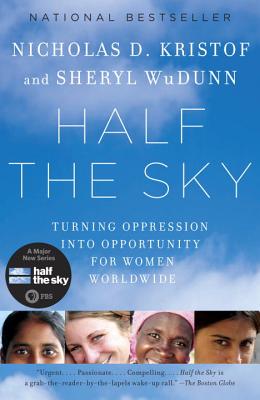Nicholas D. Kristof has for some years been a regular contributor to the op-ed page of The New York Times where he frequently writes about sex trafficking, child abuse, and the lives of women around the world.
In 2009 Kristof and his wife and writing partner, Sheryl WuDunn, published a volume that examined a wide variety of the ways women are oppressed around the world titled, Half the Sky: Turning Oppression into Opportunity for Women Worldwide. The book moves from Congo to China to South Africa to Cameroon to Afghanistan and many places in between. And though their focus is on the more dramatic and life threatening problems such as maternal mortality, prostitution, rape, AIDS, and economic discrimination, to their credit they also include the role that attitudes and practices surrounding the menstrual cycle play in determining the fate of women. In effect, they have added their own voices to the ongoing project of the SMCR: MAKING MENSTRUATION MATTER.
Half the Sky (the title is an allusion to the Chinese proverb, “Women hold up half the sky.”) is not reluctant to address ancient, deep-seated cultural traditions, including the vicious practice in Deuteronomy calling for stoning to death of girls suspected of having had premarital sex, and in a chapter titled “Is Islam Misogynistic?” they confront some of the darker portions of that faith’s history. For instance, they cite the writings of a “ninth-century scholar, Al-Timmidhi,” who “recounted that houri [the heavenly virgins who await martyrs] are gorgeous young women with white skin, who never menstruate, urinate, or defecate.” The chapter goes on to explain how statements such as this are not consistent with other Islamic tenets nor with the beliefs of many Muslims, but the notion that menstruation is equivalent to processes of bodily waste elimination is a deep-seated conception that permeates many other belief systems as well.
Another chapter, “Investing in Education,” addresses the challenges involved in providing adequate schooling for girls and the need for sanitary facilities and products so that girls can manage their periods discretely and hygienically. Mention is made of a Proctor & Gamble project to distribute free pads in Africa, however, surprisingly, insufficient attention is given to home-grown efforts, such as SMCR member Megan White Mukuria’s ZanaAfrica, to provide both products and empowering education to girls in Kenya. One program called Camfed, for Campaign for Female Education, that operates in several African countries is justifiably credited for its thoroughness in addressing girls’ education, including the practice of supplying girls with pads and underwear so they can continue to go to classes during their periods.
Obviously, an entire book could be written about the links between women’s liberation and the menstrual cycle. Half the Sky is not that book, but it does make a contribution that is worthy of applause.



Bravo -David. Wonderful post. I am familiar with Half the Sky – and the proverb. Thank you for this uplifting note as we end another tumultuous year for women.
Great to see authors including menstruation in their analysis of global oppression. Unfortunately it is so often unacknowledged, particularly in mainstream media, in discussions of such issues.
Happy New Year, David & everyone else at SMCR!